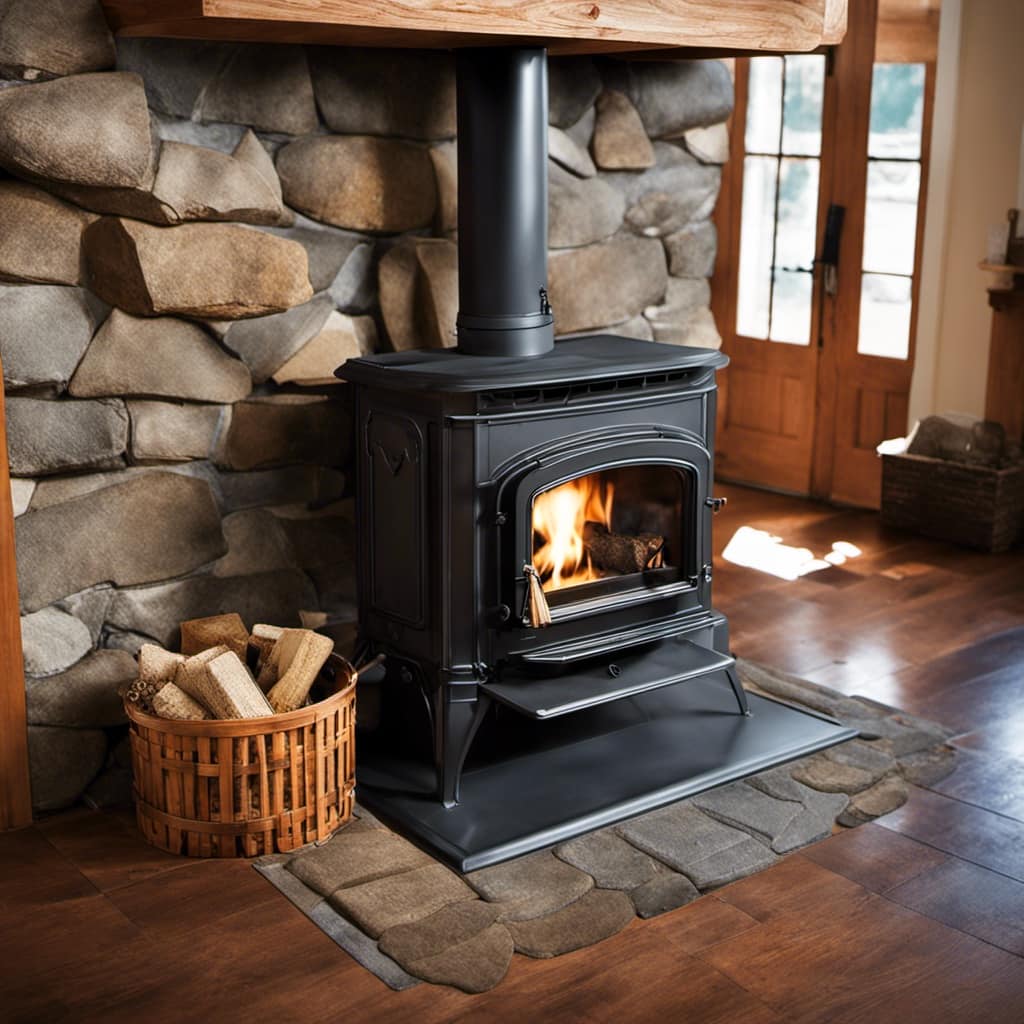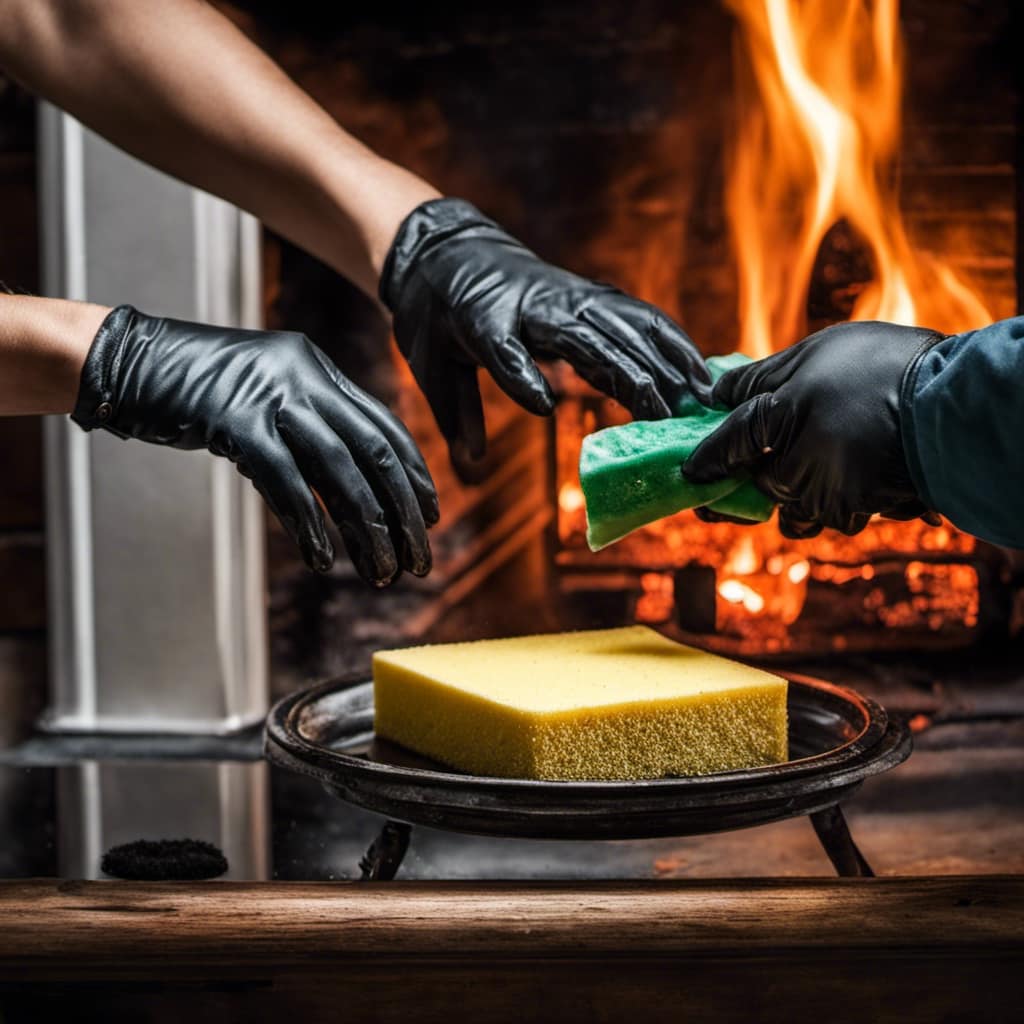I have learned from difficult situations that neglecting to remove ash from my wood stove can result in disastrous consequences.
The irony is, the more you use your stove, the more ash accumulates, and the more vital it becomes to clean it regularly.
In this article, I’ll share my knowledge and experience on determining how often to clean your wood stove ash.
Get ready to learn the signs, factors to consider, and a recommended cleaning schedule to keep your wood stove functioning efficiently and safely.

Key Takeaways
- Neglecting regular ash cleaning poses a fire hazard.
- The frequency of cleaning depends on factors such as usage and the type of wood stove.
- Professional ash cleaning services offer thorough cleaning and inspection.
- Regular cleaning improves the stove’s efficiency and ensures safe operation.
The Importance of Regular Ash Cleaning
I can’t stress enough how essential it’s for me to clean the ash from my wood stove regularly. As someone who’s been using a wood stove for many years, I’ve learned the importance of proper maintenance and upkeep.
Neglecting regular ash cleaning can have serious consequences. Firstly, it poses a fire hazard. The accumulation of ash can block airflow and cause the stove to overheat, potentially leading to a dangerous fire. Secondly, it can affect the efficiency of the stove. Ash buildup restricts airflow and reduces the stove’s ability to produce heat effectively.
On the other hand, opting for professional ash cleaning services offers numerous benefits. Professionals have the expertise and tools to thoroughly clean the stove, ensuring optimal performance and safety. They can also inspect the stove for any potential issues that may need attention.
Regular ash cleaning isn’t something to be taken lightly, and investing in professional services is a wise decision for any wood stove owner.

Factors to Consider When Determining Cleaning Frequency
When determining how frequently to remove the residue from my wood stove, I take into account various factors. Here are three important factors to consider when deciding how often to clean the ash from your wood stove:
Frequency of use: If you use your wood stove on a daily basis, you may need to clean the ash more frequently compared to someone who only uses it occasionally.
Type of wood: Different types of wood produce varying amounts of ash. Hardwoods, such as oak or maple, tend to produce less ash compared to softwoods like pine. The type of wood you burn can affect the cleaning frequency.
Efficiency of the stove: A well-designed, efficient wood stove will produce less ash and require less frequent cleaning. Investing in a high-quality stove can reduce the cleaning frequency while still enjoying the benefits of a cozy fire.

Regular cleaning of the ash from your wood stove has several benefits. It improves the stove’s efficiency, reduces the risk of fire hazards, and ensures proper airflow for optimal burning. By considering these factors and cleaning your wood stove regularly, you can enjoy a safe and efficient heating experience.
Recommended Cleaning Schedule for Different Types of Wood Stoves
As a wood stove owner, I find it important to consider the recommended cleaning schedule for different types of wood stoves. Proper maintenance is crucial to ensure the efficient and safe operation of your stove. The cleaning frequency for pellet stoves and EPA certified wood stoves may vary slightly. Here is a helpful table outlining the recommended cleaning schedule for each type:
| Type of Wood Stove | Cleaning Frequency |
|---|---|
| Pellet Stove | Every 1-2 weeks |
| EPA Certified Wood Stove | Every 1-3 months |
It’s important to note that these frequencies are general guidelines and may vary depending on usage and individual stoves. Regular cleaning helps prevent the buildup of ash, which can impede airflow and reduce the stove’s efficiency. In the next section, we will discuss the signs that indicate your wood stove ash needs cleaning.
Signs That Your Wood Stove Ash Needs Cleaning
Regularly checking for an accumulation of debris in my stove is crucial to ensure it continues to function properly. As an experienced wood stove owner, I’ve learned to pay attention to certain indicators that tell me when it’s time to clean the ash.

Here are three signs that your wood stove ash needs cleaning:
Reduced efficiency: If you notice that your wood stove isn’t heating your home as effectively as before, it could be a sign of ash buildup. As ash accumulates, it restricts airflow, reducing the stove’s efficiency.
Excessive smoke: When your wood stove starts producing more smoke than usual, it could mean that the ash has built up to a point where it’s hindering proper combustion. Cleaning the ash can help restore proper airflow and reduce smoke emissions.
Difficulty in starting a fire: If you’re struggling to ignite a fire or experiencing frequent extinguishing, it could be due to a thick layer of ash. Cleaning out the ash will allow for better airflow and make it easier to start and maintain a fire.

To ensure optimal performance, it’s recommended to clean the ash from your wood stove at least once a week or whenever you notice these indicators. Regular maintenance frequency will keep your wood stove running efficiently and extend its lifespan.
Tips for Efficient and Effective Ash Cleaning
Maintaining a clean and clear path for airflow is essential in ensuring that my wood stove operates efficiently. To maximize heat output and reduce fire hazards, regular ash cleaning is crucial.
I recommend cleaning the ash from my wood stove at least once a week during the heating season. When cleaning, I always make sure to wear protective gloves and use a metal scoop or shovel to remove the ash. It’s important to wait until the ash has cooled completely before cleaning to avoid any risk of fire.
Additionally, I pay special attention to the ash trap and clean it thoroughly to prevent any blockages.

Is it Necessary to Clean Ash from a Wood Stove Regularly, or is it Okay to Leave Some Ash Inside?
Regularly cleaning wood stove ash levels is essential for maintaining the efficiency and safety of your stove. Leaving excessive ash inside can restrict airflow and cause uneven burning. It’s best to clean out the ash after each use to ensure proper functioning of your wood stove.
Frequently Asked Questions
Can I Use Regular Cleaning Products to Clean the Ash From My Wood Stove?
I use regular cleaning products to clean the ash from my wood stove. However, there are alternative methods for cleaning wood stove ash that may be more effective, such as using a vacuum or a specialized ash cleaner.
How Long Does It Take for Ash to Accumulate in a Wood Stove?
I’ve found that the frequency of cleaning ash from a wood stove depends on how often you use it. It’s important to regularly clean it to prevent buildup and maintain efficiency. Properly disposing of the ash is crucial for safety and preventing fire hazards.
Is It Necessary to Clean the Ash From My Wood Stove During the Summer Months?
During the summer months, it is still necessary to clean the ash from my wood stove regularly. Regular cleaning improves efficiency, prevents buildup and reduces the risk of fire. Alternative methods for disposing of ash include using it as fertilizer or compost.
Can I Dispose of the Ash in My Regular Household Trash?
I generally dispose of wood stove ash in my regular household trash, but it’s important to consider the environmental impact. There are other disposal methods like composting or using it as a soil amendment.

Are There Any Safety Precautions I Should Take When Cleaning the Ash From My Wood Stove?
When cleaning wood stove ash, it’s important to take safety measures. Wearing protective gloves is crucial to protect your hands from potential burns or irritation.
Conclusion
In the fiery dance of a wood stove, ash may seem like a mere afterthought. But beware, for neglecting its cleaning can lead to a smoky rebellion! Regular ash cleaning is vital to maintain the efficiency and safety of your wood stove.
By considering factors such as wood type and stove design, you can determine the optimal cleaning frequency. Keep an eye out for telltale signs that your stove needs attention, and follow our expert tips for efficient and effective ash cleaning.
Harness the power of the flame, and keep your wood stove burning bright!

Growing up surrounded by the vast beauty of nature, Sierra was always drawn to the call of the wild. While others sought the comfort of the familiar, she ventured out, embracing the unpredictable and finding stories in the heartbeat of nature.
At the epicenter of every remarkable venture lies a dynamic team—a fusion of diverse talents, visions, and passions. The essence of Best Small Wood Stoves is crafted and refined by such a trio: Sierra, Logan, and Terra. Their collective expertise has transformed the platform into a leading authority on small wood stoves, radiating warmth and knowledge in equal measure.











